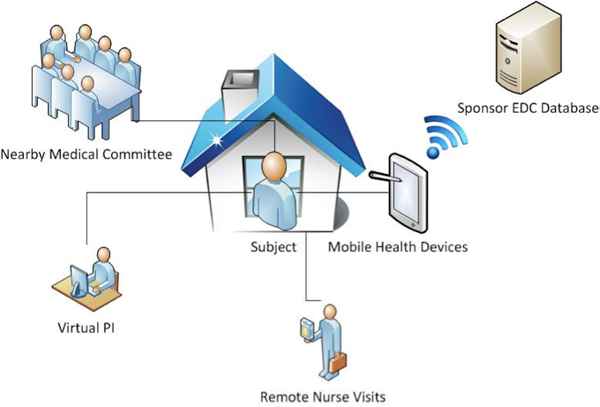Future Clinical Trials Are Here and How They May Succeed
With the increasing challenges associated with bringing a medical product to market, and skyrocketing R&D costs, there has been a shift in biopharmaceutical commercialization and clinical trial strategies in order to minimize risk and maximize success.
With the increasing challenges associated with bringing a medical product to market, and skyrocketing R&D costs, there has been a shift in biopharmaceutical commercialization and clinical trial strategies in order to minimize risk and maximize success. It is estimated that bringing medical products to market costs $1.3 billion [1], and 1 out of every 5000 experimental compounds achieve FDA approval [2]. Moreover, market saturation in many disease modalities is also forcing biopharmaceutical enterprises to focus their efforts on accessing patients with orphan/rare diseases.
There has also been a drastic shift in clinical trial IT that is forcing not only biopharmaceutical enterprises, but also the FDA to rethink how we conduct clinical trials more efficiently. For instance, some IT systems offer advanced visualizations that incorporate public information with mapping technology and statistics for site feasibility selection. Other IT companies are implementing electronic consenting that enhances regulatory compliance by tracking patient behavior while reading, agreeing and signing the consent. Some biopharmaceutical enterprises are pushing the limits by interacting with the FDA in order to implement efficient and cost-effective virtual clinical trials.
The Challenges Biopharmaceutical Enterprises Face
Since many biopharmaceutical enterprises are pursuing patients with orphan/rare diseases, it is oftentimes difficult to find and enroll those subjects, as they tend to reside in remote regions, making site feasibility and selection not only difficult and wasteful, but also unsuccessful. For example, in cancer clinical trials, it costs approximately $50,000 to initiate a study site, and 20%-30% of study sites never enroll a patient [3]. In addition, 85% of cancer patients seek treatment at private oncology clinics, and only 50% of private oncology clinics conduct clinical trials, resulting in minimal clinical trial patient exposure [3]. Some biopharmaceutical companies have designed a disruptive concept surrounding how clinical trials would likely be conducted in the future.
The ‘Future Clinical Trial’ Concept: Virtual Trials
A biopharmaceutical company recently presented a breakthrough concept of a virtual clinical trial. The illustration below shows how this biopharmaceutical company plans to engage patients, consent them, enroll them, and monitor/collect subject data throughout the trial.

The sponsor plans to engage the patient through social media, such as Facebook, and regular e-mail updates in order to attract the patient to the trial, and once the patient agrees to learn more about the trial, the sponsor mails the patient a package containing mobile health devices, which collect medical diagnostic data and sends that data to the sponsor. The patient turns on the tablet, which contains an electronic consent and a video of a physician explaining the clinical trial in detail. Humanization in digital media is believed to be an effective tool that is used to communicate with patients.
The following model briefly illustrates an overview how this remote trial is planned to be conducted:

During the clinical trial, the subject is able to access live physicians either virtually or through nearby medical community centers. Remote nurses visit the subject at their homes to collect samples. In addition, the patient uses the mobile health device to automatically upload study data directly to the sponsor's EDC database.
The Benefits
The potential benefits of this particular study design could include reduced site initiation fees, minimized subject visits, remote access to study subjects, accurate medical data, the elimination of source document verification, lower subject dropout rates, and higher patient engagement levels through training videos and electronic messages via tablets.
The Challenges
Some studies have suggested that engaging patients requires a level of trust, which exists in both pharmacies and doctors’ offices [4]. According to some industry experts, this level of trust does not exist through social media and websites, which may pose enrollment challenges because of a lack of patient engagement.
What Would Make This Trial Design Even More Successful?
Enrollment seems to be the biggest challenge in this design. Since the level of trust is relatively absent in online media, biopharmaceutical sponsors will need to implement engaging communications solutions in order to speak to, and move the patient. In addition, sponsors could access social media platforms that have higher enrollment success rates. Moreover, education on the general concept of clinical trials could also promote patients to enroll [4]. For instance, I remember, as a research coordinator, that patients oftentimes associated clinical trials with guinea pig experiments, however, patients gained interest in clinical trials after I explained the concept to them, and pointed out that there is a significant amount of medical monitoring and oversight by federal authorities to ensure the safety of the patient.
Despite the outcomes that influence risk averse behavior in clinical trials at the biopharmaceutical sponsor level, which I have reported on previously, it is a gem to see groundbreaking clinical trial concepts emerge. With clinical IT solutions moving at light speed, and patients becoming more accessible online, sponsors will need to reach, attract and engage patients through simplifying advanced scientific information, and developing appealing content in the digital space.
By Moe Alsumidaie, VP Analytics & Clinical Affairs, DNA Clinical Communications. Moe Alsumidaie can be reached here. If you are interested in joining the discussion, apply to the Breakthrough Solutions in Clinical Trials & Healthcare Group
[1] http://www.sciencebasedmedicine.org/what-does-a-new-drug-cost/
[2] Abbott, Ryan. Big Data and Pharmacovigilance: Using Health Information Exchanges to Revolutionize Drug Safety. Abstract Iowa Law Review 04/30/13
[3] A Patient-Focused Solution for Enrolling Clinical Trials in Rare and Selective Cancer Indications: A Landscape of Haystacks and Needles. Eric B. Lynam, Jiin Leaw, and Matthew B. Wiener Drug Information Journal, July 2012; vol. 46: pp. 472-478, first published on April 18, 2012
[4] Getz, Kenneth. Impact of In-Pharmacy Education on Patients’ Knowledge and Attitudes about Clinical Trials. Tufts University School of Medicine, January 2013